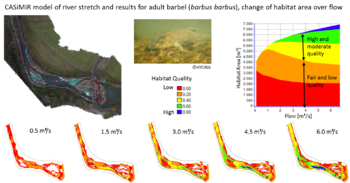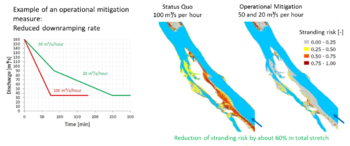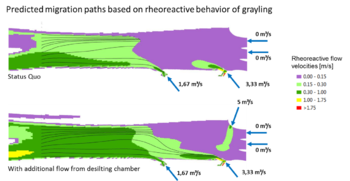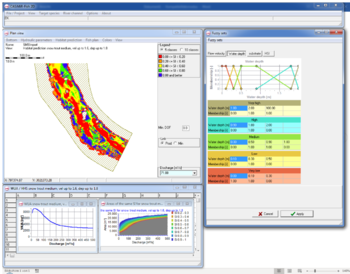Difference between revisions of "CASiMiR"
Bendikhansen (talk | contribs) |
Bendikhansen (talk | contribs) |
||
| Line 1: | Line 1: | ||
=Quick summary= | =Quick summary= | ||
| − | [[file: | + | [[file:casimir_fish.png|thumb|350px|Figure 1: CASiMiR model of river stretch and results for adult barbel.]] |
| − | [[file: | + | [[file:casimir_hydropeaking.png|thumb|350px|Figure 2: Example of an operational mitigation measure: reduced downramping rate.]] |
| − | [[file: | + | [[file:casimir_migration.png|thumb|350px|Figure 3: Predicted migration paths based on rheoreactive behaviour of grayling.]] |
| − | [[file: | + | [[file:casimir_interface.png|thumb|350px|Figure 4: view of the CASiMiR interface.]] |
| − | |||
Developed by: SJE Ecohydraulic Engineering GmbH, Matthias Schneider, Ianina Kopecki | Developed by: SJE Ecohydraulic Engineering GmbH, Matthias Schneider, Ianina Kopecki | ||
Revision as of 11:59, 17 June 2019
Contents
Quick summary
Developed by: SJE Ecohydraulic Engineering GmbH, Matthias Schneider, Ianina Kopecki
Date:
Type: Tool
Suitable for the following [[::Category:Measures|measures]]:
Introduction
CASiMiR is a software package with different modules aiming at the assessment of impacts of human measures on river ecology.
CASiMiR-Fish is a habitat suitability model that imports results of 2D hydrodynamic modelling and relates them to the requirements of aquatic species, such as different life stage of fish species, macroinvertebrates or macrophytes. The model delivers quantitative information on the quality and availability of hydro-morphological habitats and their changes, caused by changes in hydrology (temporal flow features), hydraulics (spatial flow feature) and morphology (Figure 1). In contrast to other habitat suitability models, it is based on a multivariate approach that is able to integrate rules for the description of habitat requirements. These rules are generated based on data evaluation and/or ecological expertise.
CASiMiR-Hydropeaking is a model able to process unsteady flow data for habitat risk assessment. Dynamic parameters as ramping rates (water level changes over time) are used to assess the stranding risk or drift risk for young fish during rapidly changing flows that occur in rivers under hydropeaking impact (Figure 2). Additionally, the “habitat persistence” as an indicator for the sustainability of habitats for organisms with restricted mobility (larvae, macroinvertebrates) can be quantified and assessed for different scenarios of turbine operation and morphological mitigation.
CASiMiR-Migration is an agent-based model developed within FITHYDRO. It is used to assess the effectiveness of the attraction flow downstream of fish passes. It is based on the evaluation of hydraulic features such as flow velocity-magnitude, -direction and -gradient as well as morphological features such as river bottom gradients, vicinity of flow obstacles to predict favorable and unfavorable swimming paths for migratory fish (Figure 3).
Application
CASiMiR integrates interfaces for several 2D hydrodynamic models such as Hydro-AS_2D, SRH, BASEMENT, FLUMEN, River2D. The model has been applied in rivers of most different dimensions, types and stretches with lengths between several 10 meters to sections of several dozens of kilometres length (Figure 4).
CASiMiR is unique in that it makes use of physical and biological parameters through the application of expert knowledge using fuzzy logic-based rule systems, but can also use the standard preference function method as well. The main advantages of using habitat simulation models are:
- The ecological condition of an aquatic ecosystem is directly coupled with the living conditions of the typical resident species.
- The use of habitat models allows for the effects of changing flow rates and structural characteristics to be account for and can be used to predict their impacts.
- Changes to the flow rate and morphology result primarily in impacting the water depth, flow velocity, and substrate conditions, all of which are major factors in determining the habitat suitability and can be directly evaluated with numerical models.
- Due to the direct relationship between habitat conditions and flow rate, a quantitative basis can be established whereby an overall ecological assessment of the habitat requirements can be performed.
Other information
Base versions of CASiMiR are free for download under http://www.casimir-software.de. Advanced versions can be purchased via mailbox@sjeweb.de. Scientific and commercial licenses are available.
Relevant literature
- Noack, M., Schneider, M. and Wieprecht, S. (2013): The Habitat Modelling System CASiMiR: A Multivariate Fuzzy Approach and its Applications; in Ecohydraulics: An Integrated Approach, Chapter 6 (75-93); Editors I. Maddock, A. Harby, P. Kemp, P. Wood, John Wiley & Sons Ltd
- Schneider, M., Kopecki, I., Tuhtan, J., Sauterleute, J., Zinke, P., Bakken, T., Zakowski, T., Merigoux, S. (2016): A Fuzzy Rule-based Model for the Assessment of Macrobenthic Habitats under Hydropeaking Impact. River Research and Applications, 1467-1535
- Kopecki, I., Tuhtan, J., Schneider, M., Ortlepp, J., Thonhauser, S., Schletterer, M. (2014): Assessing Fishway Attraction Flows Using an Ethohyraulic Approach. 3rd IAHR Europe Congress, Porto, April 14-16.



